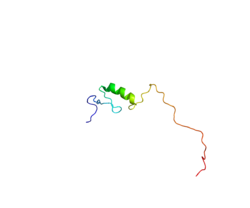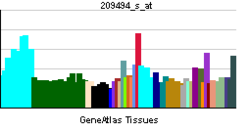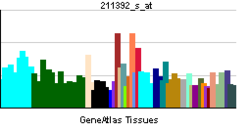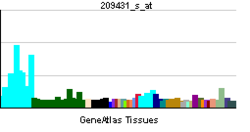- PATZ1
-
POZ (BTB) and AT hook containing zinc finger 1 
Rendering based on PDB 2EPP.Available structures PDB 2EPP, 2EPQ, 2EPR, 2EPS, 2YT9 Identifiers Symbols PATZ1; MAZR; PATZ; RIAZ; ZBTB19; ZNF278; ZSG; dJ400N23 External IDs OMIM: 605165 MGI: 1891832 HomoloGene: 8636 GeneCards: PATZ1 Gene Gene Ontology Molecular function • DNA binding
• chromatin binding
• zinc ion binding
• metal ion bindingCellular component • intracellular
• nucleusBiological process • regulation of transcription, DNA-dependent
• spermatogenesis
• male gonad development
• T cell differentiation
• negative regulation of transcription, DNA-dependentSources: Amigo / QuickGO RNA expression pattern 


More reference expression data Orthologs Species Human Mouse Entrez 23598 56218 Ensembl ENSG00000100105 ENSMUSG00000020453 UniProt Q9HBE1 n/a RefSeq (mRNA) NM_014323.2 NM_019574.2 RefSeq (protein) NP_055138.2 NP_062520.1 Location (UCSC) Chr 22:
31.72 – 31.74 MbChr 11:
3.19 – 3.21 MbPubMed search [1] [2] POZ-, AT hook-, and zinc finger-containing protein 1 is a protein that in humans is encoded by the PATZ1 gene.[1][2][3][4]
The protein encoded by this gene contains an AT-hook DNA binding motif, which usually binds to other DNA binding structures to play an important role in chromatin modeling and transcription regulation. Its Poz domain is thought to function as a site for protein-protein interaction and is required for transcriptional repression, and the zinc-fingers comprise the DNA binding domain. Since the encoded protein has typical features of a transcription factor, it is postulated to be a repressor of gene expression. In small round cell sarcoma, this gene is fused to EWS by a small inversion of 22q, then the hybrid is thought to be translocated (t(1;22)(p36.1;q12). The rearrangement of chromosome 22 involves intron 8 of EWS and exon 1 of this gene creating a chimeric sequence containing the transactivation domain of EWS fused to zinc finger domain of this protein. This is a distinct example of an intra-chromosomal rearrangement of chromosome 22. Four alternatively spliced transcript variants are described for this gene.[4]
Interactions
PATZ1 has been shown to interact with RNF4,[5][6] Microphthalmia-associated transcription factor[7] and Androgen receptor.[6]
References
- ^ Dunham I, Shimizu N, Roe BA, Chissoe S, Hunt AR, Collins JE, Bruskiewich R, Beare DM et al. (Dec 1999). "The DNA sequence of human chromosome 22". Nature 402 (6761): 489–95. doi:10.1038/990031. PMID 10591208.
- ^ Fedele M, Franco R, Salvatore G, Paronetto MP, Barbagallo F, Pero R, Chiariotti L, Sette C, Tramontano D, Chieffi G, Fusco A, Chieffi P (Apr 2008). "PATZ1 gene has a critical role in the spermatogenesis and testicular tumours". J Pathol 215 (1): 39–47. doi:10.1002/path.2323. PMID 18241078.
- ^ Tian X, Sun D, Zhang Y, Zhao S, Xiong H, Fang J (Apr 2008). "Zinc finger protein 278, a potential oncogene in human colorectal cancer". Acta Biochim Biophys Sin (Shanghai) 40 (4): 289–96. doi:10.1111/j.1745-7270.2008.00405.x. PMID 18401526.
- ^ a b "Entrez Gene: PATZ1 POZ (BTB) and AT hook containing zinc finger 1". http://www.ncbi.nlm.nih.gov/sites/entrez?Db=gene&Cmd=ShowDetailView&TermToSearch=23598.
- ^ Fedele, M; Benvenuto G, Pero R, Majello B, Battista S, Lembo F, Vollono E, Day P M, Santoro M, Lania L, Bruni C B, Fusco A, Chiariotti L (Mar. 2000). "A novel member of the BTB/POZ family, PATZ, associates with the RNF4 RING finger protein and acts as a transcriptional repressor". J. Biol. Chem. (UNITED STATES) 275 (11): 7894–901. doi:10.1074/jbc.275.11.7894. ISSN 0021-9258. PMID 10713105.
- ^ a b Pero, Raffaela; Lembo Francesca, Palmieri Emiliano Antonio, Vitiello Carmen, Fedele Monica, Fusco Alfredo, Bruni Carmelo Bruno, Chiariotti Lorenzo (Feb. 2002). "PATZ attenuates the RNF4-mediated enhancement of androgen receptor-dependent transcription". J. Biol. Chem. (United States) 277 (5): 3280–5. doi:10.1074/jbc.M109491200. ISSN 0021-9258. PMID 11719514.
- ^ Morii, Eiichi; Oboki Keisuke, Kataoka Tatsuki R, Igarashi Kazuhiko, Kitamura Yukihiko (Mar. 2002). "Interaction and cooperation of mi transcription factor (MITF) and myc-associated zinc-finger protein-related factor (MAZR) for transcription of mouse mast cell protease 6 gene". J. Biol. Chem. (United States) 277 (10): 8566–71. doi:10.1074/jbc.M110392200. ISSN 0021-9258. PMID 11751862.
Further reading
- <Please add first missing authors to populate metadata.> (1999). "Toward a complete human genome sequence". Genome Res. 8 (11): 1097–108. doi:10.1101/gr.8.11.1097. PMID 9847074.
- Kobayashi A, Yamagiwa H, Hoshino H et al. (2000). "A Combinatorial Code for Gene Expression Generated by Transcription Factor Bach2 and MAZR (MAZ-Related Factor) through the BTB/POZ Domain". Mol. Cell. Biol. 20 (5): 1733–46. doi:10.1128/MCB.20.5.1733-1746.2000. PMC 85356. PMID 10669750. http://www.pubmedcentral.nih.gov/articlerender.fcgi?tool=pmcentrez&artid=85356.
- Fedele M, Benvenuto G, Pero R et al. (2000). "A novel member of the BTB/POZ family, PATZ, associates with the RNF4 RING finger protein and acts as a transcriptional repressor". J. Biol. Chem. 275 (11): 7894–901. doi:10.1074/jbc.275.11.7894. PMID 10713105.
- Mastrangelo T, Modena P, Tornielli S et al. (2000). "A novel zinc finger gene is fused to EWS in small round cell tumor". Oncogene 19 (33): 3799–804. doi:10.1038/sj.onc.1203762. PMID 10949935.
- Pero R, Lembo F, Palmieri EA et al. (2002). "PATZ attenuates the RNF4-mediated enhancement of androgen receptor-dependent transcription". J. Biol. Chem. 277 (5): 3280–5. doi:10.1074/jbc.M109491200. PMID 11719514.
- Mitchelmore C, Kjaerulff KM, Pedersen HC et al. (2002). "Characterization of two novel nuclear BTB/POZ domain zinc finger isoforms. Association with differentiation of hippocampal neurons, cerebellar granule cells, and macroglia". J. Biol. Chem. 277 (9): 7598–609. doi:10.1074/jbc.M110023200. PMID 11744704.
- Morii E, Oboki K, Kataoka TR et al. (2002). "Interaction and cooperation of mi transcription factor (MITF) and myc-associated zinc-finger protein-related factor (MAZR) for transcription of mouse mast cell protease 6 gene". J. Biol. Chem. 277 (10): 8566–71. doi:10.1074/jbc.M110392200. PMID 11751862.
- Strausberg RL, Feingold EA, Grouse LH et al. (2003). "Generation and initial analysis of more than 15,000 full-length human and mouse cDNA sequences". Proc. Natl. Acad. Sci. U.S.A. 99 (26): 16899–903. doi:10.1073/pnas.242603899. PMC 139241. PMID 12477932. http://www.pubmedcentral.nih.gov/articlerender.fcgi?tool=pmcentrez&artid=139241.
- Collins JE, Wright CL, Edwards CA et al. (2005). "A genome annotation-driven approach to cloning the human ORFeome". Genome Biol. 5 (10): R84. doi:10.1186/gb-2004-5-10-r84. PMC 545604. PMID 15461802. http://www.pubmedcentral.nih.gov/articlerender.fcgi?tool=pmcentrez&artid=545604.
- Gerhard DS, Wagner L, Feingold EA et al. (2004). "The Status, Quality, and Expansion of the NIH Full-Length cDNA Project: The Mammalian Gene Collection (MGC)". Genome Res. 14 (10B): 2121–7. doi:10.1101/gr.2596504. PMC 528928. PMID 15489334. http://www.pubmedcentral.nih.gov/articlerender.fcgi?tool=pmcentrez&artid=528928.
Categories:- Human proteins
- Chromosome 22 gene stubs
Wikimedia Foundation. 2010.
